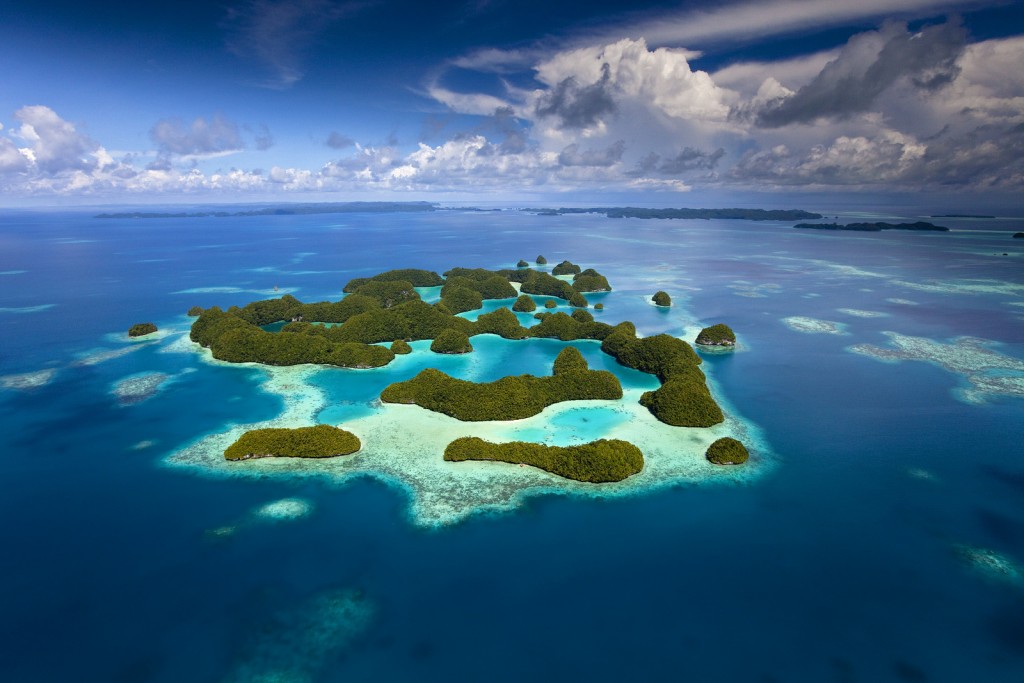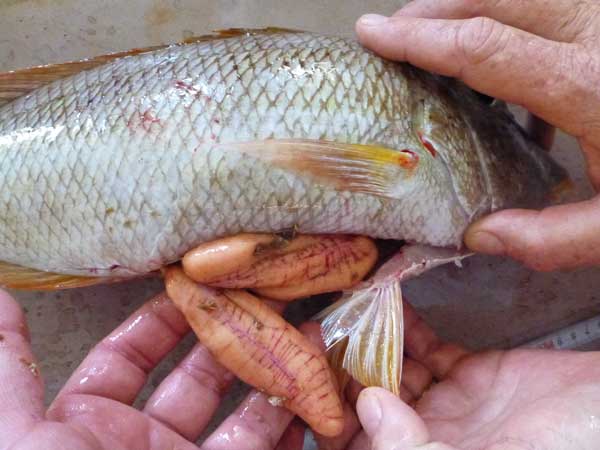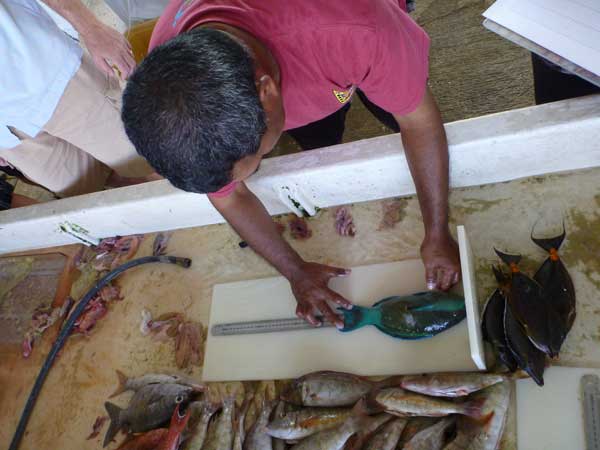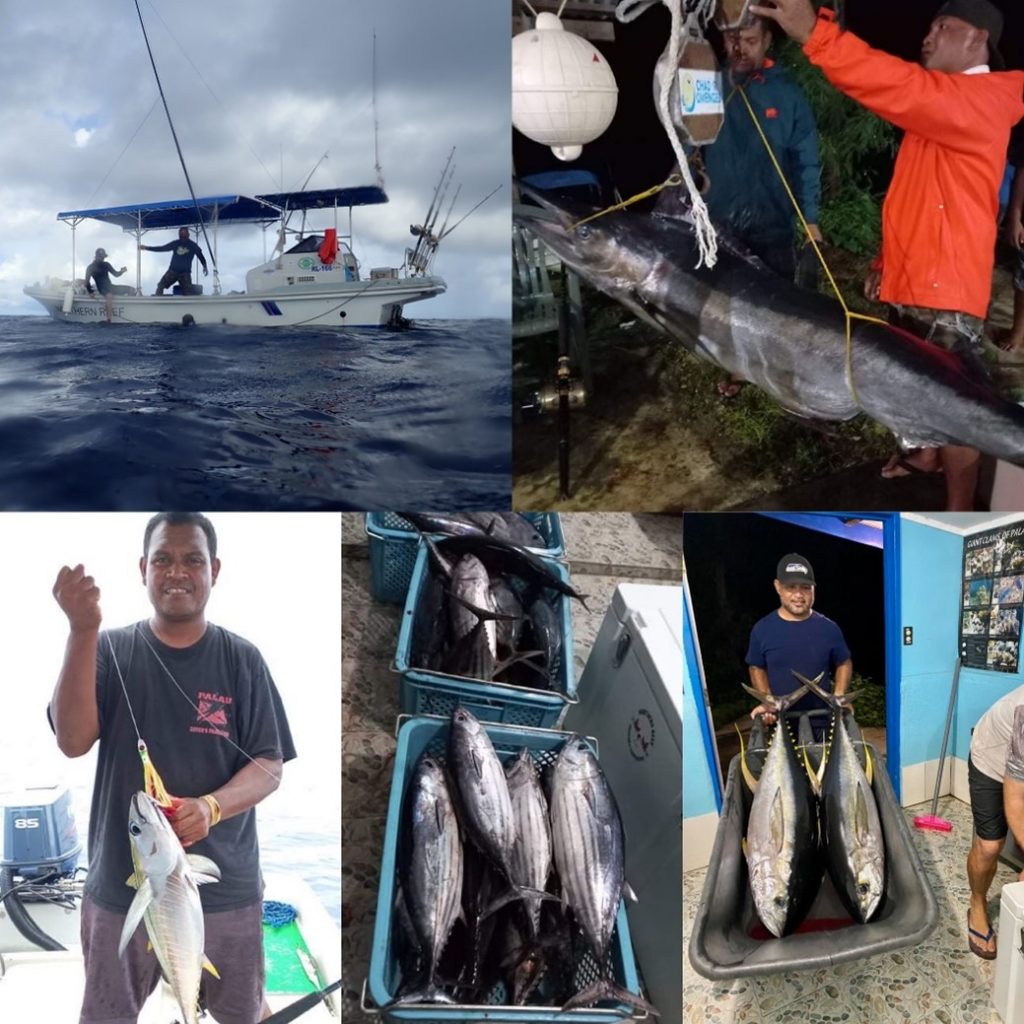Reforming Palau’s Data-Poor Reef Fisheries through Community-Based Approaches
Location
Babeldaob, Ollei, Palau
The challenge
Palau is composed of 12 inhabited islands and over 700 islets stretching over 700 km. It has numerous island and reef types, including volcanic and raised limestone islands, atolls, barrier reefs around much of the main island cluster, and fringing reefs in the south. Palau has the most diverse coral fauna of Micronesia, including approximately 400 species of hard corals, 300 species of soft corals, 1400 species of reef fishes, thousands of invertebrates, and Micronesia’s only saltwater crocodiles.

Aerial view of Palau known as “70 Mile Islands” as well as the rich coral reef surrounding them. Photo © Ian Shive
For centuries, Palau’s waters have provided sustenance. The Northern Reefs – the second largest fishing ground in Palau – are depended on by fishers and the surrounding communities for food, livelihoods, and income. In fact, Palauans have some of the highest per capita fish consumption compared to other regions in the Pacific and modern fishing practices have increased fishing pressure across the country. Even though Palau has a deeply-rooted conservation ethic and a large network of marine protected areas (MPAs), the increased fishing pressure has not been able to keep stocks sustainable, and there is a growing awareness that protected areas alone are insufficient to maintain viable fish populations.
To manage a fishery sustainably, it is necessary to have information about the stock: how many fish, what species, how quickly they grow and reproduce, and how many can be harvested without putting the fishery in danger of collapse. But traditional stock assessments are so expensive and resource intensive, requiring years of data collected by trained experts at a cost of hundreds of thousands of dollars or more per stock, that they are prohibitive for most fisheries, especially those in developing countries. And without the stock data to inform management decisions, data-poor fisheries like those in Palau’s Northern Reefs can easily become overfished, threatening the livelihoods and food security of the people who depend on them.
Actions taken
In 2012, The Nature Conservancy established a pilot project in the Northern Reefs to assess stock status using data-limited stock assessment techniques, to improve fisheries management through a community-driven approach, and to rebuild fish stocks. From August 2012 to June 2013, trained fishers helped scientists collect data on species, size, and maturity for about 2,800 fish caught in Palau’s waters. They measured their own catch as well as fish for sale at the country’s only fish market, Happy Fish Market.

Mature gonads of an emperor fish caught for the Palau Stock Assessment Project. Photo © Andrew Smith
The data-poor technique relies on sample size ratios to assess how much spawning is happening and how much is enough. At its most basic, the technique uses two pieces of local data, size of fish and maturity of fish, combined with existing biological information, to produce a ratio of spawning potential. As a general rule, if fish can achieve at least 20% of their natural lifetime spawning, a fishery can sustain itself. Less than that and the fishery will decline. While 20% is the minimum number, scientists hope to see fisheries achieving 30–50% of natural spawning. The findings in Palau were worrisome, showing that 60% of fish catch were juvenile, achieving just 3–5% of their lifetime spawning potential. The consequences of this were clear: if most fish are not reproducing, in a short time there will be no more fish.
Fishery managers and scientists presented the findings of this project at community meetings in the northern reefs. With the new knowledge provided by the data, the community integrated fishery management tools, including minimum size limits and the protection of key spawning aggregations. As a result, Palau’s northern States passed fisheries regulations for 14 species between 2015 to 2018. These regulations included three-year moratoriums on the harvest of six species of groupers from the family Serranidae and length-based size limits for these groupers and eight other important species as part of an adaptive fisheries management strategy to stabilize and restore these important fish populations. Furthermore, in the years following the implementation of the Northern Reefs fisheries management plan, the Covid-19 pandemic created unprecedented challenges for Palau and the reliance on coral reef fisheries for Palauan food security created an urgent need to build the capacity of the nation’s domestic pelagic fisheries to ensure food security, reduce fishing pressure on the reefs, and support local economic development. To this end, The Nature Conservancy responded to this crisis by helping the local fishing community in the Northern Reefs build their capacity to fish pelagic species and meet the local communities demand for marine protein with pelagic fish.
How successful has it been?
More than six years have passed since these fisheries management actions were first enacted on the Northern Reefs and 10 years have passed since the original baseline assessment of these fisheries resources. During this time, the life history estimates have been revised and the most recent estimates of spawning potential ratio indicate that as of 2021, spawning potential ratio has increased for seven of the nine species that could be evaluated between 2012 and 2022. Of these species, the spawning potential ratio (SPR) of Lutjanus gibbus, Naso lituratus, Lethrinus olivaceus, Lethrinus xanthochilus, Lutjanus bohar and Variola louti increased, while the SPRs of Lethrinus rubrioperculatus and Chlorurus microrhinos have decreased. Furthermore, an analysis of the limited Plectropomus areolatus data suggests the status of the stock had recovered to 33% upon the opening of its fishery in 2018; the moratorium was effective in recovering the stock, but it has since declined. This follow up fisheries assessment is still underway as of 2022. As the sample size of the fisheries additional species grows, the impact of these management actions will be evaluated for all the species that comprise the fisheries of the Northern Reefs. However, these initial results suggests that fisheries management has improved the status of many of the regions key species and the data-limited stock assessment techniques are helping support adaptive management by identifying species that need additional conservation efforts.

Measuring fish length as part of the Palau Stock Assessment Project. Photo © Andrew Smith
In addition to coral reef fisheries management, The Nature Conservancy has helped the local fishing community in the Northern Reefs shift their fishing effort from heavily exploited shallow water coral reef species toward more robust pelagic species that live outside the reef by supporting alternative costal pelagic fisheries development. These efforts included supporting the Choose Pelagic marketing initiative, the deployment of a Fish Aggregating Device (FAD) five miles offshore from Ollie, conducting a series of FAD fishing trainings and capacity building efforts with the Northern Reefs Fisheries Cooperative and trialing new echo sounder buoy technology as part of a collaboration between The Nature Conservancy, the FAO FishFAD project, and the Palau Bureau of Fisheries. This echo buoy technology provides local fishers with the location and biomass of aggregating tuna, improves sea safety and access, and reduces the uncertainty associated with pelagic fishing by allowing local fishers to forecast the presence of tuna at the FAD.

The Northern Reefs Fisheries Cooperative fishing vessel and catches of pelagic species made from the vicinity of the FAD located in the Northern Reefs. Photo © Northern Reef Fisheries Cooperative (NRFC)
Finally, the success of any natural resource management depends greatly on enforcement and compliance. In March 2014, The Nature Conservancy and WildAid partnered to design an enforcement system for Palau’s Northern Reefs that is practical, affordable, and feasible to implement over a four-year time frame. The system provides strategic sensor coverage to key fishing areas, MPAs, and access ways. The strategy combined high-power video cameras and a robust VHF marine radio network with the strategic placement of buoys, patrol vessels, and a floating barge to provide a constant presence and fast response capacity throughout both marine managed areas (MMAs). However, due to the high maintenance cost of the video camera piloted, it was not feasible, although the system could have had potential if there was an available technician on the island. The Northern Reef Fisheries Cooperative to this date continues their effort to improve surveillance and enforcement and is currently in the process of securing an engine for the floating barge to support surveillance on the water. Continued efforts to strengthen enforcement are on the way with continued support from WildAid and the Palau National Protected Area Network Office (PANO).
Lessons learned and recommendations
- Solving the overfishing problem is never easy – there are trade-offs and sacrifices.
- Management options range from imposing size limits to closing areas for a certain length of time until fish populations can rebound. But these choices, which tend to be contentious and complicated to work out, are much easier to adopt and apply when fishers are part of assessing the problem and are engaged in discussing the solutions.
- Cooperative effort between scientists and fishers has been key to the success of the project. Palauan fishers’ extensive knowledge and experience helped inform the scientific process and increase community awareness of the problem.
- Women and their role in community-based fisheries is important and should also be recognized in any resource management efforts
- Developing alternative pelagic fisheries alongside coral reef conservation efforts takes time but in the face of global change if motivated community members are outfitted with the appropriate equipment, training and experience these fisheries can increase the resilience of fishing communities and diversify the food base of the community.
Funding summary
The David and Lucile Packard Foundation
Palau Protected Areas Network Fund
Ministry of Agriculture, Fisheries & Environment formally Ministry of Natural Resources, Environment & Tourism (MNRET)
Lead organizations
The Nature Conservancy
Ministry of Agriculture, Fisheries & Environment formally Ministry of Natural Resources, Environment & Tourism (MNRET)
Partners
Palau International Coral Reef Center
Palau Conservation Society
Bureau of Fisheries formally Bureau of Marine Resources
Palau Protected Areas Network Fund
Koror State Government Department of Coastal Management & Law Enforcement (DCLE)
WildAid
Division of Fish & Wildlife Protection, Ministry of Justice
Secretariat of the Pacific Community (SPC) Murdoch University
The FAO FishFAD Project
Resources
Video: A Breakthrough for Data-Poor Fisheries Starts in Palau




